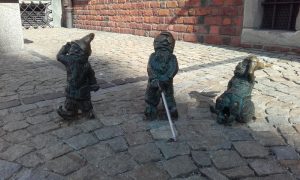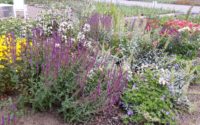Where Did The Lwów Folk Go?
Wrocław (pronounced Vrots – wav) is a city in western Poland, in a region called Silesia, which after WW2 not only became Polish once again but for the first time saw its entire German citizenry expelled. Historically Silesia was always shared among Poles, German speaking peoples of Saxony and Austrians.
25.09.2017
I’m about to depart Kraków. After checking out, there is another guest on the lift and when he says good morning, his accent is Northern Irish. A small world right enough – his name is Peter Campbell and he’s from Bangor! His wife is of Ukrainian origin and her grandmother, or perhaps it was great-grandmother served in the court of the Czar Nicholas. Her family are from Kiev. he and his wife have never been there but would like to go. They said the route and layovers were unsuitable so I told him how I went. I wonder if he’ll come into the shop for a chicken now?
I cannot remember the first time I was in Gdańsk or Warsaw, but recent visits there have nevertheless have to count as second visits. Today it’s Wrocław and this is my first visit. It takes three and a half hours on the train from Kraków to Wrocław. You forget that here trains don’t run directly between cities. This particular train started in Przemyśl in south eastern Poland and terminates in Słupsk in north western Poland. The journey takes 15 hours.
First impression of Wrocław is positive. Just as Gdańsk, Warsaw and Kraków, tramcars stop within a couple of minutes walk from where I am staying. The Hotel is thoroughly modern, quite quirky. The Old City is just across the road; just what I want. This attractive city sits on either side of the River Odra ( Oder in German ) and whilst Kraków is the best known city break destination for British visitors, Wrocław is considered by many Poles to be superior.

Finding a place to eat in a city you don’t know, in the dark, is a hit or a miss. In my case fortunately it’s the former; a restaurant called ‘Kociołek’ which specialises in grills on cast iron plates. Chicken, pumpkin, courgettes, sun-dried tomatoes, carrots, onions, sesame seeds, roast potatoes and I’ve still missed some things out. It is studded with flavours. Once again an example of the Poles putting a different angle on their own cuisine.
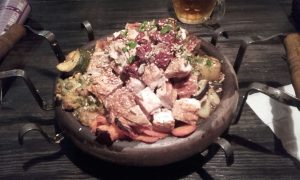
26.09.2017
Silesian dialect is the common language in Wrocław and is it any wonder with it’s history.
I had written, in July to an organisation in Wrocław asking for help in local history and they wrote back saying they would be delighted and to let them know nearer the time I was to be in Wrocław. I did this last week and received a curt reply this morning saying they could not help and brushing me off with a 2 hour guided tour conducted in English at an extortionate price. I write back to say that I am disappointed that they had backtracked on their original offer and they reply (through Google translator because they alleged that no one there spoke English) that how could they possibly help because Lwów was now a Ukrainian city – well what do you know! – and nothing to do with them because Wrocław has no connection to Lwów! Somebody’s telling lies or she needs to top up on local history. Her final sentence was if I did not do the tour then good luck to me! Well, that took my feet from under me and for a few moments Wrocław became an unfriendly place. What to do? Coffee of course and time to think a new strategy. I came here for a reason; because there was a close connection between Lwów and Wrocław after WW2 and I would like to find out if any of my Polish family was part of that movement of population to Wrocław. If someone tries to help but cannot because of no evidence that’s still progress and I can accept that. Another possibility I need to consider seriously is that no one is either interested nor cares any more. That is understandable as the people here want to move on.
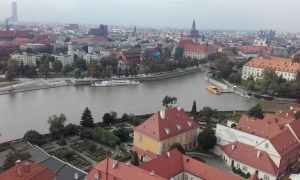
I am able to get a lead albeit a weak one from the tourist information office in Rynek Ratusz (City Hall Square). Try the National Archive in Wrocław which I do. This building looks pre-war; I get the feeling that the infills on the walls are old bullet holes. I try the usual approach; Google translate what I want to ask the receptionist who sits behind the heavy oak entrance door. Incredibly he hands me a locker key and directions to Room 106 which is the Reading Room. Behind the door the room is surrounded on all sides by hard bound leather books and loose bound paper. Where to start? Fortunately a woman who looks that she is in charge of Room 106 asks if she can help. My limited understanding of Polish stretches that far but a response does not so thankfully I’ve not deleted the question I had saved for the receptionist. The woman asks if I speak German and I say yes with fingers crossed behind my back that the vocabulary is not over technical. Thankfully I do understand completely what she is saying. She asks what is it exactly I’m after as the information, if it still exists may be a bit scattered and if I could be more precise then that might help. She suggests I go away armed with the Archive’s email address and send in what information I know. That makes sense and I’ll do it before I leave Wrocław. I could easily, as I am prone to do, spew out a load of family history and just end up confusing the issue with stuff that whilst interesting is not terribly relevant. It must have been an ordeal for those people displaced from Lwów. Imagine someone who has lived all of their life in the south of England and whose forebears did so also, being moved suddenly somewhere in the north of England. Both regions of England are markedly different. Imagine for a moment too, that you have to move from one bombed out ruin of a city to another bombed out ruin.

Still clutching at any old straw, I pass by the Wrocław City Museum and in I go (managing to avoid paying) just to see if by some small chance there might be a section on the Lwów people who were displaced here by the USSR in 1945-47. What there is has very little to do with that topic but nevertheless the exhibition in itself is very interesting for getting a grasp of the city’s rich history. Nationality, until the 19th century had little to do with the everyday lives of the citizens. Power grabs had more to do with land than national borders and the local princes and dukes might be Polish, German, Bohemian or Silesian but no discrimination was exercised except with religion but even then it was not extreme. It was the rise of French nationalism and Napoleon’s campaigns that triggered the same sentiment in Central Europe. Twenty years after the partitions of Poland, the Prussians began discriminating against the Poles, a situation that grew worse under Bismarck, when he united the rest of the German speaking lands under Prussian rule, then Kaiser Wilhelm II and the rest up to 1945 is well known history. After 1945, the situation went into reverse with the Poles expelling Germans and so it went on. Today through the EU, Wrocław is at peace with itself again – a cosmopolitan city where one again Poles and Germans mingle.
Anyway to compensate for an empty Wrocław family file, there is a restaurant on the Rynek Ratusz called Karczma Lwówska. If I cannot find any potential relatives, maybe I can enjoy the food they would have eaten. It transpires that the owners parents did indeed come from Lwów and at that moment I almost spew out the idiotic ‘would they have known the Pach or Moszoro family?’ My brain resumes command in an instant.
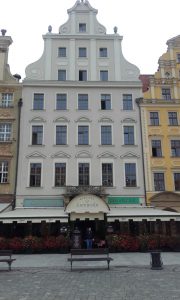
27.09.2017
The Cathedral Isle (Osrtrów Tumski) is recommended. It is a fine day so a leisurely stroll to the Cathedral, by way of a large indoor market called Hala Targowa. You could probably buy most things here and it looks like this is where the locals come, judging by how busy it is, leaving we poor gullible tourists to the fancy rip-off stalls in Rynek Ratusz. There is even a seamstress busying away. You’d have to look hard to find one in UK. most stalls are heaving with food and drink. The biscuits and cakes are magnetic – but no – it’s the Cathedral and no diversions.
The Cathedral is really a Cathedral Quarter with four other churches, one other belonging to the Orthodox tradition and a seminary. The Cathedral itself is dedicated to St.John the Baptist, is neo-Gothic style and is the fourth to be built on the same site, the first having been in the mid 10th century. Why so many? I’ll have a guess and say it had less to do with a demand for Mass and more with some king’s or prince’s or duke’s passport to Heaven.
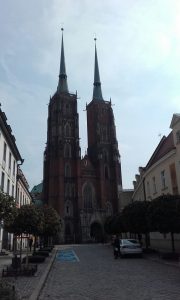
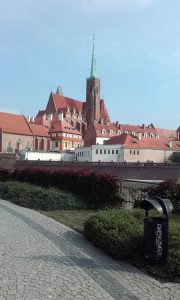
I should leave the Japanese Garden until tomorrow and make it special.
I almost forgot to mention the little statues of the dwarfs that are everywhere but you really have to look. It’s a curious history dating to 2001 and the Polish Orange Alternative movement which was anti-communist. The dwarf is the group’s symbol and the first was placed in a nearby square and with the tolerance of the City Council, more have appeared. They have become so popular that tourists are invited to find the dwarf challenges and there is even a dwarf festival held annually in September.
A meal at a renowned pierogini and there is a humorous saying on the wall:
‘W pocie czoła pracujemy bo nakarmić Was dziś chcemy’
We work in sweat, because today we are feeding you.
I am pleased I made the decision to travel to Dresden en route to Leipzig on Friday by bus. I am not laid back enough to not think, two or three days before the event, about making four train changes and hoping there are no delays. I can just board the bus in Wrocław and waken up in Dresden.

28.09.2017
I make the trip to the Japanese Garden, which is not exactly well signposted considering it was put to me as something special. It is fine but not exactly a ‘bucket list’ attraction. I can understand why they have not gone overboard with signage. You can walk round it very quickly, but at least I can tell the person that recommended it that I went.
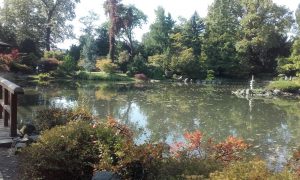
I cannot remember the last time I sat outside in a short sleeved shirt in late September. The wet weather in Kraków is not even a memory while the city itself is a pleasant one.
I am enamoured of Wrocław. There is something relaxing; being hemmed in on all four sides by stunning old Baroque style buildings; you just pick out the features and dwell on them and the colours as you sit in a cafe on a sunny day, sipping latte and picking at a savoury pancake. The Poles are quite proficient in stacking away plates of food. Yesterday at the indoor market I saw a couple downing plates of potato and savouries at 10.30 in the morning.
You appreciate the roles the Poles, Germans, Silesians and Bohemians played in defining the character of this fine old city. The Germans call it Breslau but out of respect call it by its Polish name when talking to locals. Would a compromise by to revert to its Latin name; Vratislavia? No, it sounds like Bratislava.
This is my final full day this trip in Poland. I have found out and learned much; even understanding or having a general understanding of what is being said. It will take practice, but the Poles, not expecting outsiders to know the language are delighted when you try and offer encouragement. I feel comfortable and have been made to feel comfortable here in Poland. Germany tomorrow and the start of the road back.
Ends
